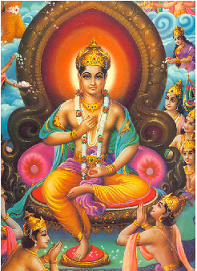 |
| Prabhapala is invited by the Devas
in the Tushita Heaven to come down on earth
to save all beings |
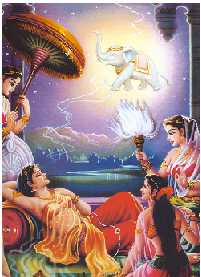 |
| Queen Mahamaya Devi dreamt a wonderful dream,
that a white elephant, holding a white
lotus in its trunk, entered her womb
through the right side, coming into mother's womb. |
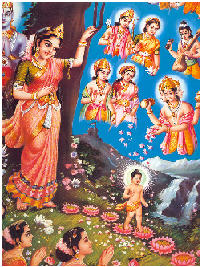 |
| The Buddha was born at Lumbini Garden. |
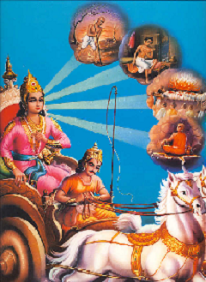 |
| In his outings through the four gates of the
city, prince Siddhartha realizes the true circle
of life: birth, old age, illness and death. |
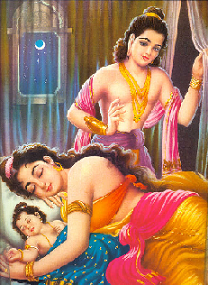 |
| On the day son Rahula was born, the Prince Siddhartha looks at his wife and son before leaving the palace,
before the Prince bonded with son. Otherwise, it will be very difficult for the Prince in wilderness in search of
Enlightenment if father and son is strongly bonded.
|
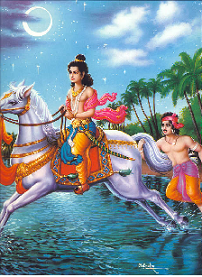 |
| Prince Siddhartha and the charioteer ride the
horse Kanthaka, leave the city of Kapilvastu,
cross the Anoma river and start a homeless life.
|
|
Propagation carries a veiled meaning of bringing a greater number of
adherents under the common bondage of what is taken up to propagate. In this
particular sense, Buddhism falls behind by a few significant steps that
otherwise could promote its propagation and cultural unity more promising
prospect to a more broader area than it is now. As far as I could make out, one
of those steps is an International Buddhist Calender, a small item of every
one's daily necessity with mighty power to exert tremendous influence of
religious significance.
The year of Prince Siddhartha's birth is not uniformly followed throughout the Buddhist world. The root of this chronological uneven
practice lies far back into a remote age when up keeping of records in writing was unknown. An ancient drawback is always a modern problem.
But, civilisation is advanced enough to leave no such problem unsolved. This one also, I believe, is not beyond solution for the Buddhist
countries by their chronological Pundits.
Important though, this chronological inexactitude should not be considered as hindrance to start compiling an International Buddhist
Calendar, that can be given a refined finishing touch in due course. Therefore, let us leave this point for the present and try to venture
one, in as sensible a way as possible.
Although silent about the year, our Scripture has maintained a pin point accuracy as to the month and day on which the Prince was born. Here it is in Pali:-
Okkanti Guruvaramhi Vijayi Sukkavasare,
Kikkhami Candavaramhi Sambujjhi Budhavasare.
Soravara Khamma-Cakkam Angavare ca Nibbuto,
Tejadaddho Adiccamhi sattavara kata ime.
Nibatti Abhisambodhi Parinibbanameva ca,
Tissima Lokanathassa Vesakhi Punnamashiyam;
Abhinikkhsmanaceva Dhamma-cakka-pvattanam,
Dvete Lokanathassa Aslhi Punnamashiyam;
Ayusankhara-mossajji Magha-punnama shiyam Jino,
Tayo ete Mahamasha mashattayam kata ime.
To give a free rendition, I should record here:-
Thursday was the Day of Germination (coming into mother's womb). Friday was the Day of Birth. The Great Renunciation took place on Monday. Wednesday
was the Holiest Day of Enlightenment. The wheel of Law (Dhamma Cakka) was set in Motion on Saturday. On Tuesday the Lord entered into Nibbana.
The Funeral took place on Sunday.
Birth, Enlightenment and Parinibbana (Demise), these three events took place on the Full Moon Day of Veshakha (May). The Great Renunciation and
the setting in motion of the Wheel of Law occurred on the Full Moon Day of Ashala (July). On the Full Moon Day of Magh (February), the Lord declared
that He will enter into Nibbana on the following Full Moon Day of Veshakha (May). These are the reasons why the three months were called Mahamasha,
the Great Months.
The foregoing quotation is very clear about all principal events of the Lord's life that occurred all over the seven days of a week.
We can pick up from here the Pali names of a week's seven days. They are :-
Adicca : Sunday
Candavara : Monday
Angavara : Tuesday
Budhavasara : Wednesday
Guruvara : Thursday
Sukkavasara : Friday
Soravara : Saturday
It is simple and easy enough to cover the week of a Buddhist Calendar with these Pali names of the seven days, according to the Scriptural Records.
They have been deduced following the names of seven Planets as they were and are known in Sanskrit. But, "The whole Universe is within this fathom-long
body" and the Planets are not non-members of what we have known as universe. Again, Buddhism is an international Religion, and as such, I don't find any
beneficial reason of using these names for an international purpose. This might probably have been one of the other possible reasons, as to why nobody
has ever cared to smell a clue for a International Buddhist Calendar, during the long period of the Religion's influence over a wide international area.
Now, the most salient point here is : whether the seven days' names should remain as they have been found in the Scripture, or not. If not, they should
be indentified with something else, which might prove to be a constant source of significant inspiration for the entire Buddhist population of the world.
With an international outlook to suit the modern trend, an ultra modern idea may worth a lot here. And, with that back-ground in mind, I beg to record
that we, the Buddhist, are at large to exploit our Scripture in any suitable way, which may spark a noble pride in our hearts, that we are the followers
of "The Greatest Son of man the world has ever produced". Mine is a different idea, sharp in character and fanatic in flavour. But, it is exactly what
it should be. Its object is most eventful. Its approach is precisely realistic in getting to what the plan specifically aims at, very closely following
this principal events of the Lord's life. Here is the idea :-
Tathagata's Funeral took place on Sunday. I would objectively prefer to name this day as "DAHANADAY". The Pali word, that has been used to mean 'Funeral',
is 'Tejadaddho'. 'Teja' : Heat or fire and 'Daddho' : burned; in other words, burned by or in fire. "Dagdha" is the Sanskrit word from which 'Daddho' has been
derived in Pali. It enjoys the popular usage as an adjective and its basic noun form is 'Dahan'.
Prince Siddhartha renounced the world (Kikkhami) on Monday, the Full Moon Day of July (Ashala). It would therefore be very sensible and significant to name
this day as "NIKKHAMANADAY", 'Nikkhaman' being the noun form of the verb 'Nikkhami'.
The Great Demise of the Lokanatha had its occurrence on Tuesday, The Full Moon Day of May (Vesakha). Therefore, NIBBANADAY would probably be the most
appropriate and suitable for this day to be named.
He attained Enlightenment on Wednesday, the Full Moon Day of May (Vesakha). Following this Holy Event of the Lord's life, I would very much incline to call this day as "SAMODHIDAY".
On the Full Moon Day of July (Ashala). King Suddhodhana's Queen Mahamaya Devi dreamt a wonderful dream, that a white elephant, holding a white lotus in its trunk, entered her womb
through the right side. It was Thursday. According to the Scriptural records, this was the day on which Prince Siddhartha, the Sambuddha to be, came to his mother's womb (Okkanti).
To commemorate this Great Coming, I like to coin the word "OKKANTIDAY", for memorable set up of the fifth day of the Week in our International Buddhist Calendar.
Friday, the Full Moon Day of Vesakha (May), was the most happiest and memorable day for the mankind of centuries ahead. On this auspicious Day Prince Siddhartha
was born in the forest of the garden of Lumbini. Devas and men of the three Lokas (Kama Loka, Rupa Loka and Arupa Loka) greatly rejoiced on this Day in welcoming
SAMBUDHA to be. Today, let us also rejoice in designating this Great Day as "JATIDAY", for decorating the sixth day of our calendar.
For the first time in the known and made known history of mankind, the Wheel of Law (Dhamma Cakka) was set in motion in the Deer Park of Saranath on Saturday,
the Full Moon Day of July (Ashala). In order to keep an ever lasting impression of this Holy Occurrence in mind, I would like to call it "CAKKADAY", and pay my
devoted homage to this Great Event of the life of the Teacher of Devas and men.
The Pali words, most humbly selected here to stand for the days of a week, are all in noun forms, except the one (Okkanti) to take the place of Guruvara (Thursday).
They are to play the role of adjectives by qualifying the noun (Day), added to each of them to complete the terminologies. The other one (Okkanti), though a verb itself,
is to act as an adjective having prefixed to qualify the noun (Day) that followed.
In accordance with what I have detailed so far, the brief account of the seven days should run thus:-
Sunday : Dahanaday : The Day of Funeral
Monday : Nikkhamanaday : The Great Renunciation Day
Tuesday : Nibbanaday : The Day of Great Demise
Wednesday : Sambodhiday : The Day of Enlightenment
Thursday : Okkantiday : The Day of Coming into Mother's Womb
Friday : Jatiday : The Day of Birth
Saturday : Cakkaday : The Day of Setting the Wheel of Law in Motion
Naming the seven days of a week in the calendar, following the principal events of Buddha's life, has a beautiful aim to achieve. The very utterance of
each day's name in this objective way, is sure to bring in instantly a holy remembrance of a Great Event of Buddha's life. And a sublime reflection of these
Events repeatedly, day after day - week after week, is almost sure to attract a Buddhist much more closer to the Master. Again, while this slow but steady
flow of earning gradual proximity of the Master will keep on its obscure running, His unheard of Tenets, as a matter of fact, will also take their own course
to gain ground in the heart without one's won notice. To acknowledge this invaluable underground course of wholesome chain-reaction, I should say : accumulation
of goodness drop by drop, one succeeding the other, is better if continued, and in the long run outstands as best to get to the goal.
This is all about the days of a week. What about the months? To give the calendar a higher possible Buddhistic flavour, the twelve months should not be left
out of consideration. According to my small idea, twelve months of a year should popularised after the sacred names of twelve outstanding Arahats, who attained
the Holy and Sanctified Stages direct under the Master's instructions and training, and lived through his life time. The main point, to be carefully adhered to
here, is that a Holy Arahat's month of birth should be the one, to be designated after His sacred names. Indeed, this will call for a meticulous research and
that should not be spared by any means.
Note:
The same author has also left another idea of teaching Abhidhamma on the Screen. Abhidhamma is the higher Doctrine of Buddhism, which explains Mind and Mental
Factors together with Material Qualities, Feelings, Functions, Base, Doors etc. Abhidhamma on the Screen will be implemented later in this web site.
|
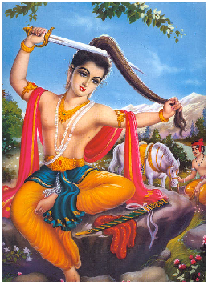 |
Cutting off his hair, the Prince instructs
Chana to return to the palace with his garments,
ornaments and precious sword.
|
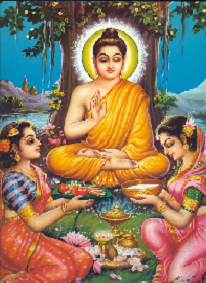 |
Deciding to follow the Middle Path, the Prince
abandones ascetic life and accepts a bowl of
milk-rice offered by Sujata.
|
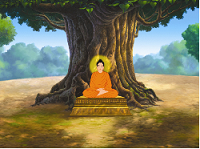 |
Prince Siddahartha attains Enlightenment under the Bodhi tree after defeating Mara
|
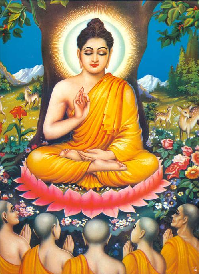 |
Turning the Dharma Wheel the first time at the
Deer Park, the Buddha expounds the Four
Noble Truths to the first five ascetic
friends.
|
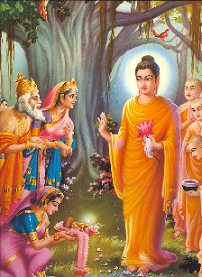 |
The Buddha returns to Kapilavathu to visit
King Suddhodana and to preach Dharma to
his royal relatives.
|
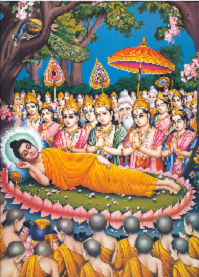 |
The Buddha attains Parinibbana in the Sala
Grove, between the twin Sala tress, in the
vicinity of Kusinagara.
|
 |
Buddha's body was cremated here, in the
vicinity of Kusinagara.
|
|